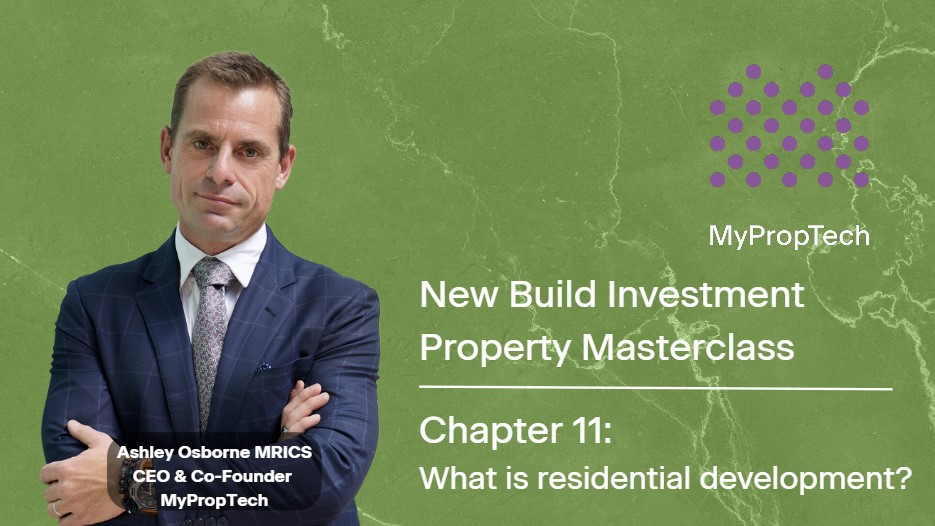New Build Investment Property Masterclass: Chapter 4 - New Build Market Fundamentals
You cannot make an informed investment decision without a fundamental understanding of the new-build market. Therefore, your journey must start with what the real estate market is, how it works, and what drives it.
Most people have a specific idea of what the residential real estate market is. However, very few give a much thought to real estate and what drives its value. What is it which gives one property a higher value than another?
To successfully invest in new-build property, you must understand what drives value, and how the residential development process works. Therefore, first we need to cover:
- Real estate market: What is the real estate market, and how does it work in practice?
- Residential development: What is residential development, what is the process, and how does it work? Why do you need to understand this? Because you cannot effectively negotiate with a developer unless you know what risks they face. You negotiate the best deal by overcoming and reducing these risks.
These fundamental concepts are the foundation for your overall understanding of how you can prosper through the purchasing and investment process as an off-plan investor.
The Real Estate Market
When people talk about real estate, they are typically talking about its characteristics. These are physical, institutional, and economic characteristics. People trade real estate in the abstract; they trade based on what it can provide from a combination of these characteristics, rather than the physical thing.
Physical characteristics
Many of the physical characteristics of real estate are immediately evident. However, others are less so.
- Land: Its location, size, the views it provides, exposure to sunlight, and other environmental features are usually evident from a simple visual inspection of the land. However, land also has other, equally important features. The load-bearing capability of the soil impacts its value, but is not known without investigation. Other factors such as soil contamination from harmful elements also affect land value, but cannot be understood without expert investigation. The value of a parcel of land depends on the costs involved in making the land productive, and whether it is profitable to do so. Additionally, the value is impacted by whether other parcels of land could deliver the same reward at lower cost.
- Improvements: To realise the full economic benefit from land, improvements need to be made on or to it. Some of these improvements will be obvious, such as buildings and structures. However, others will be less obvious, like drainage, filling, clearing, levelling, and other modifications which will help to improve its future economic utilisation.
Institutional characteristics
Land also has institutional characteristics - these are the rights that run with it, how local laws affect how it may be used, and how it is taxed.
In most European countries, the institutional characteristics flow from the tenurial system in which landed property is held. The tenurial system stems from feudal law. Feudalism was a combination of legal, economic, military, and cultural customs that existed in medieval Europe. Feudal law is a political system that placed a country’s inhabitants under a hierarchical structure, which granted superior rights to lords and vassals (a person regarded as having a mutual obligation to a lord or monarch). A principal feature of this system was its way of structuring society around relationships derived from the holding of land in exchange for service or labour. The right to all land was vested in the sovereign.
A transaction in land does not deal so much with the physical thing itself; it is more about the legal rights that run with it. This system is known as the tenurial system. In common law, land tenure is the legal regime under which land is owned by an individual, who is said to 'hold' the land. The land tenure defines how access is granted to it, the rights to use it, control it, and transfer it, as well as other associated responsibilities imposed through its ownership. This system determines who can use the land, for how long, and under what conditions.
Land tenure is typically categorised into:
- Private: The assignment of rights to a private party who may be an individual, a married couple, a group of people, or a corporate body such as a company;
- Communal: A right may exist within a community where each member of the community has a right to use the holdings of the community independently;
- Open access: Specific rights are not assigned to anyone, and no one can be excluded; or
- State: Property rights are assigned to an authority in the public sector.
The highest form of ownership under which real estate can be held under common law is a "Fee Simple Absolute" in relation to an estate in land. If you think of the individual rights that could be granted to a parcel of land as a bundle of sticks and each of the sticks represents a separate right, then a Fee Simple Absolute represents land ownership as a bundle containing all of the sticks. The Fee Simple Absolute is often referred to more simply as freehold ownership.
To keep things simple from now on, I will refer to 'fee simple absolute' as a freehold interest in the land. This freehold interest infers a series of rights and powers, such as:
- Use rights:Rights to use the land for a series of purposes;
- Control rights: Rights to make decisions on how the land should be used;
- Transfer rights:Rights to sell or mortgage the land, to convey the land to others, to transmit the land to heirs through inheritance, and to reallocate use and control rights.
It is through exercising these rights that developers and investors create various inferior interests granted to other parties, through which they can drive economic value. Importantly, the absence of some of these rights will mean either that value can be impacted, or some type of development cannot take place, which is why a lawyer (conveyancer) is needed to act on your behalf when you purchase a property. Some of these rights and obligations are obvious; however, others are not. It is the job of the conveyancer to undertake detailed investigations into the property to ensure that the interests being inferred to you as an investor are what you had envisaged.

Economic characteristics
In addition to its physical and institutional characteristics, land has economic characteristics.
Immobile
Real estate is immobile, in that it cannot be moved. This has several implications:
- Users: The pool of users for it come from a small and defined geographic location. The property cannot be moved to a market where there is greater demand from users, or where users are more affluent.
- Inhomogeneity: No two parcels of real estate are the same. Even if all other characteristics of two parcels of land are identical in all respects, their location is not.
- Income: This is derived from a fixed location. A user of real estate will only pay for the benefit it provides in a specific location.
The immobile nature of real estate has several consequences. First, there is a thin trading market for property. It is difficult to obtain a significant amount of data from sales transactions to determine value. Therefore, it is difficult to create an index for trading property which is similar to a stock exchange. By comparison, if you trade two separate parcels of 1,000 shares in a company on a stock exchange, those two parcels are identical.
Because real estate is immovable, its value is driven by its position relative to other things which drive value. For example, suppose you take two identical properties, one adjacent to the sea front and one several streets away. In that case, all other things being equal, the one adjacent to the sea front will have greater value than the other, because the 'nearness' of the property to an amenity is what drives its value.
You will have no doubt heard the saying "Location, location, location"; it comes from a quote:
Since value depends on economic rent, and rent on location and location on convenience, and convenience on nearness, we may eliminate the intermediate steps and say value depends on nearness. The next question is, nearness to what?
Richard M. Hurd
It is this ‘nearness’ that drives value rather than location specifically.
Large economic units
The purchase of real estate entails the outlay of large sums of money. In a study undertaken in the UK by the Office for National Statistics (ONS) in 2018, the average cost of buying a home was 7.77 times the average gross annual income. Australia and New Zealand have similar rates, of 7 and 8.5 times respectively. This limits the market not only to those with the desire to buy - but, equally importantly, those who can raise the funds to do so.
Durability
Land is regarded as indestructible. When the value of buildings on it declines for whatever reason, the land always remains. This is referred to as its residual value. For this reason, an insurance valuation for a property only considers the replacement value of the buildings rather than the value of the buildings with the land. This is because no matter what happens to the building, the land will always remain.
Scarcity
Land is a finite resource, in that its physical supply is limited. Because land is scarce, there is generally competition for it. Its scarcity and the competition for it determines its value.
Land by itself is unproductive
For land to be productive, the application of labour, capital, and management to it is required. These factors of production need to be combined in the property if its most profitable use is to be realised.
 By
By


